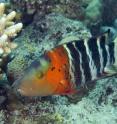Tough times for the tree of life on coral reefs
Marine scientists are calling for a re-think of how marine protected areas (MPAs) are planned and coordinated, following a global assessment of the conservation of tropical corals and fishes. Researchers from the Australian Research Council Centre of Excellence for Coral Reef Studies (Coral CoE), at James Cook University in Townsville, analysed the extent to which the evolutionary histories of corals and fishes are protected, rather than looking at individual species.
"Our interest was in evolutionary branches of the tree of life, rather than the traditional focus on rare, threatened or endemic species," said Professor David Bellwood from the Coral CoE.
"In particular we were interested in the longer branches, which represent the greater proportion of evolutionary history.
"When we looked at tropical Marine Protected Areas from that perspective, we found that protection of corals and fishes falls significantly short of the minimum conservation target of protecting 10 per cent of their geographic ranges.
"Just one sixteenth of hard corals species are afforded that minimum level of protection, and for fishes - the wrasses - less than a quarter reach minimum protection levels."
Professor Bellwood said that while it was still useful to focus on the conservation of rare, threatened and endemic species, planning protected areas around evolutionary history helped provide a deeper perspective.
"In effect, we are looking at protecting the reef equivalent of cultural heritage, the critically important history of living organisms," he said.
"It is not just species that need protection but the genetic history that they contain. In a changing world this evolutionary diversity is likely to be increasingly important, as reefs respond to new challenges.
The researchers found that the shortfall in protection for corals was greatest in the Atlantic and the Eastern Pacific.
For fishes, the highest concentrations of poor protection are in the Western Indian Ocean and the Central Pacific.
"Even though our estimates are highly conservative, the inescapable conclusion is that most evolutionary branches of the tree of life on coral reefs are inadequately protected by the current system of Marine Protected Areas," Professor Bellwood said.
Around 830,000 multi-cellular species call the world's threatened coral reefs home, and half a billion people rely on the reefs for ecosystem services including food security, income and protection against natural hazards.
"MPAs continue to provide important and essential protection to certain species and habitats, but the bigger evolutionary picture needs to be considered in planning and coordinating the choice and location of future protected areas," Professor Bellwood said.
"This is especially important in light of chronic decline due to deteriorating water quality and periodic damage by coral bleaching and cyclones."
Source: ARC Centre of Excellence in Coral Reef Studies
Articles on the same topic
- Anglers' gear, cooperation affect coral reef fisheries, Dartmouth research findsFri, 8 Jan 2016, 17:56:06 UTC
- Coral, seaweed and fishy appetitesTue, 5 Jan 2016, 16:59:04 UTC
Other sources
- NASA to Capture Best-Ever Portrait of Coral Reef Healthfrom Space.comFri, 15 Jan 2016, 20:30:36 UTC
- NASA to Capture Best-Ever Portrait of Coral Reef Healthfrom Live ScienceFri, 15 Jan 2016, 18:01:26 UTC
- Tough times for the tree of life on coral reefsfrom Biology News NetWed, 13 Jan 2016, 0:01:26 UTC
- Tough times for the tree of life on coral reefsfrom Science DailyTue, 12 Jan 2016, 18:57:56 UTC
- Tough times for the tree of life on coral reefsfrom PhysorgTue, 12 Jan 2016, 16:11:24 UTC
- Anglers' gear, cooperation affect coral reef fisheriesfrom Science DailySun, 10 Jan 2016, 20:21:29 UTC
- Anglers' gear, cooperation affect coral reef fisheries, study findsfrom PhysorgFri, 8 Jan 2016, 19:12:11 UTC
- NASA CORAL mission to raise reef studies to new levelfrom PhysorgThu, 7 Jan 2016, 13:04:31 UTC
- NASA CORAL Mission to Raise Reef Studies to New Levelfrom NASA Jet Propulsion LaboratoryWed, 6 Jan 2016, 23:22:21 UTC
- Impact of seaweed-covered corals on reef fishfrom Science DailyTue, 5 Jan 2016, 14:30:57 UTC
- Researchers evaluate how coral-seaweed interactions affect coral associated reef fishesfrom PhysorgTue, 5 Jan 2016, 13:34:05 UTC
- UD Researchers Look at Impact of Seaweed-Covered Corals on Reef Fishfrom Newswise - ScinewsMon, 4 Jan 2016, 21:46:20 UTC
